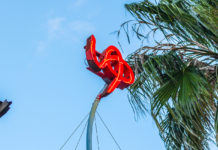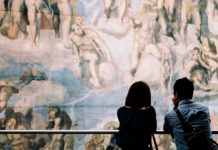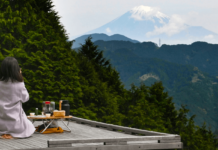It’s important to start with a disclaimer: this article contains no photographs of The Horrible Spider, so please read on without fear of a life plagued with nightmares.
Many of Japan’s cities are home to excellent museums, which explore local cultural and natural history, and Kumamoto city is no exception. Kumamoto City Museum is a short walk from Kumamoto castle, and set in picturesque parkland. As well as a vast array of exhibits detailing the material history of the wider Kumamoto prefecture, it’s also home to a large planetarium, which projects space-themed screenings throughout the day, in Japanese.
Kumamoto City Museum has an extensive collection of artefacts on permanent display, all of which are housed in a thoughtfully designed museum space, spread over three floors. The museum was completely refurbished after being damaged in the 2016 Kumamoto earthquake, opening again in 2018 with a beautifully modern and cohesive interior.
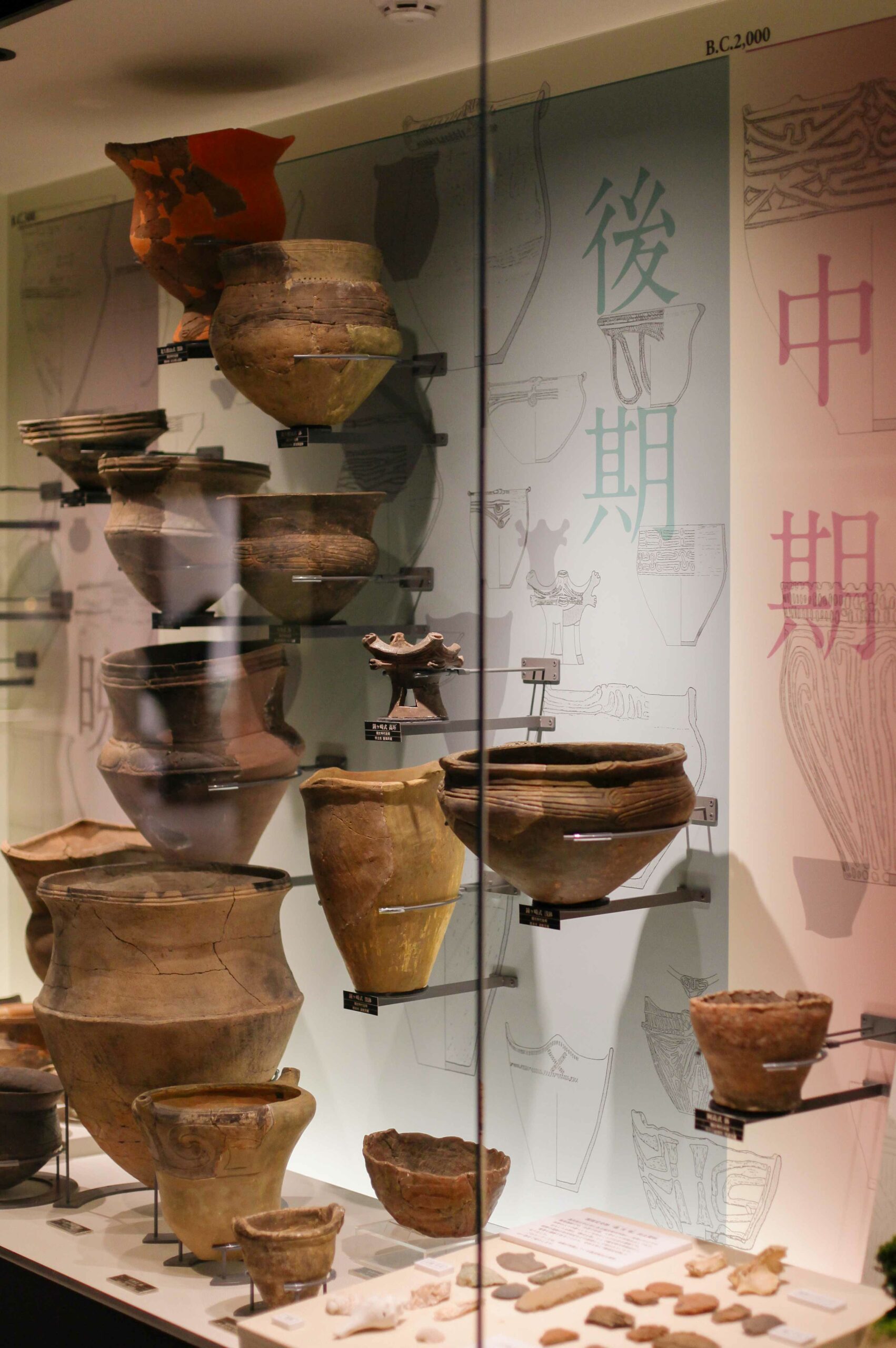

The first (ground) floor details the complete human history of Kumamoto, from the earliest Palaeolithic nomads, to the rise of the Jо̄mо̄n culture, right through to the modern-day city. The range of artefacts collected here is incredible; everything from ancient, ornate gold accessories unearthed from river basins, to unsettling ceremonial shell masks. The collection of Jо̄mо̄n earthenware pottery is extensive, and explained in great detail. While Kumamoto City Museum’s physical displays don’t prioritise English language signage, the museum offers a fully integrated app-based guide, which can be used on a smartphone. The guide comes in multiple languages, and is explained in more detail here.
A glass-lined anteroom on this floor also houses the ‘Hananomaru’ barge; an enormous leisure boat built for the Hosokawa samurai clan. The Hosokawa clan was the single most powerful clan in Japanese history, with descendants still active in politics today (most notably Hosokawa Morihiro, the 79th prime minister of Japan).
Following the Jо̄mо̄n and Yayoi periods, Japan’s Kofun period (relatively brief, lasting from western calendar years 250 – 538) was notable for its complex burial rites. Tumuli (burial mounds) from this period have yielded a huge range of archaeological data, and Kumamoto City Museum offers a wealth of information on this fascinating culture.
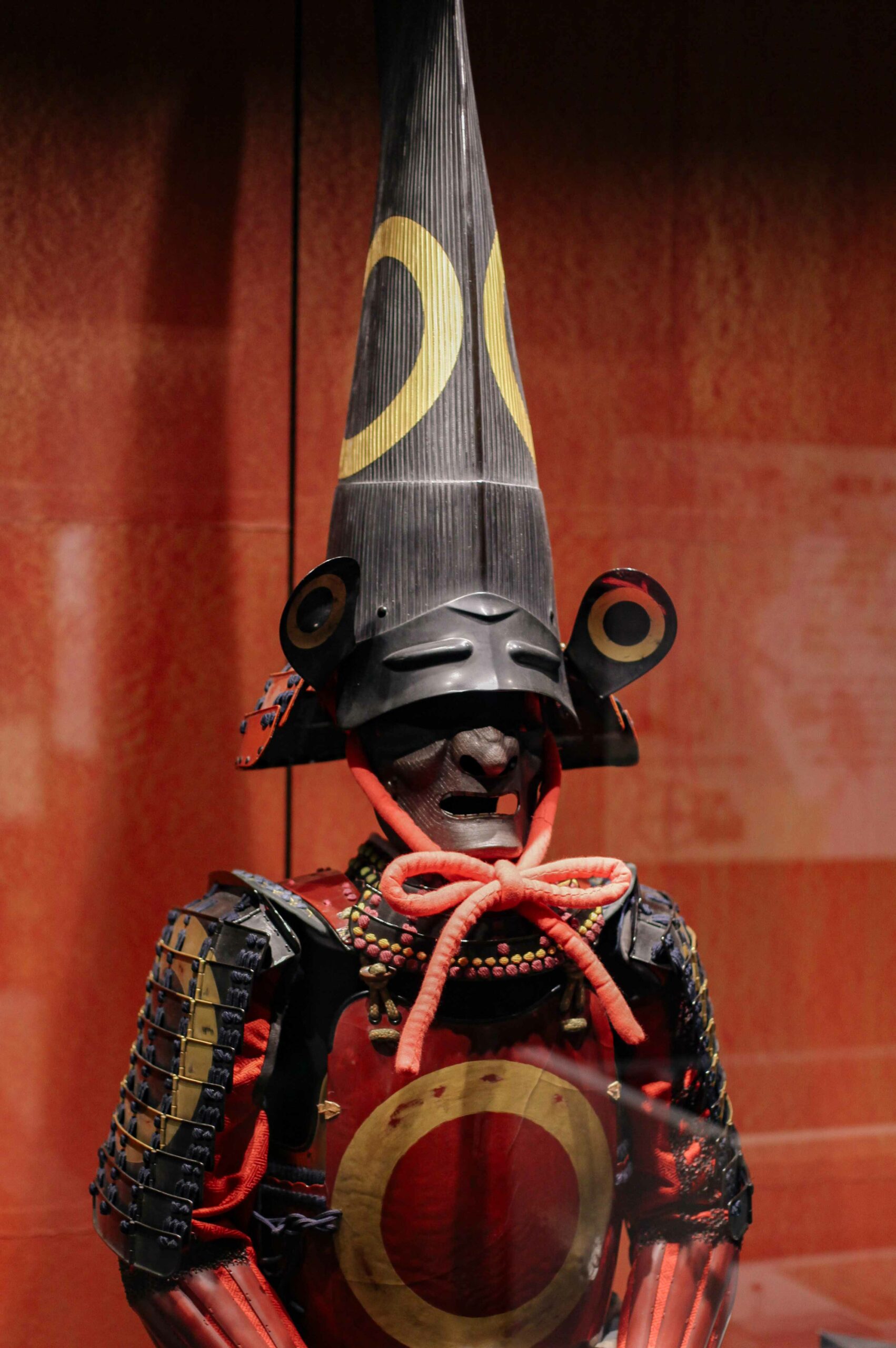
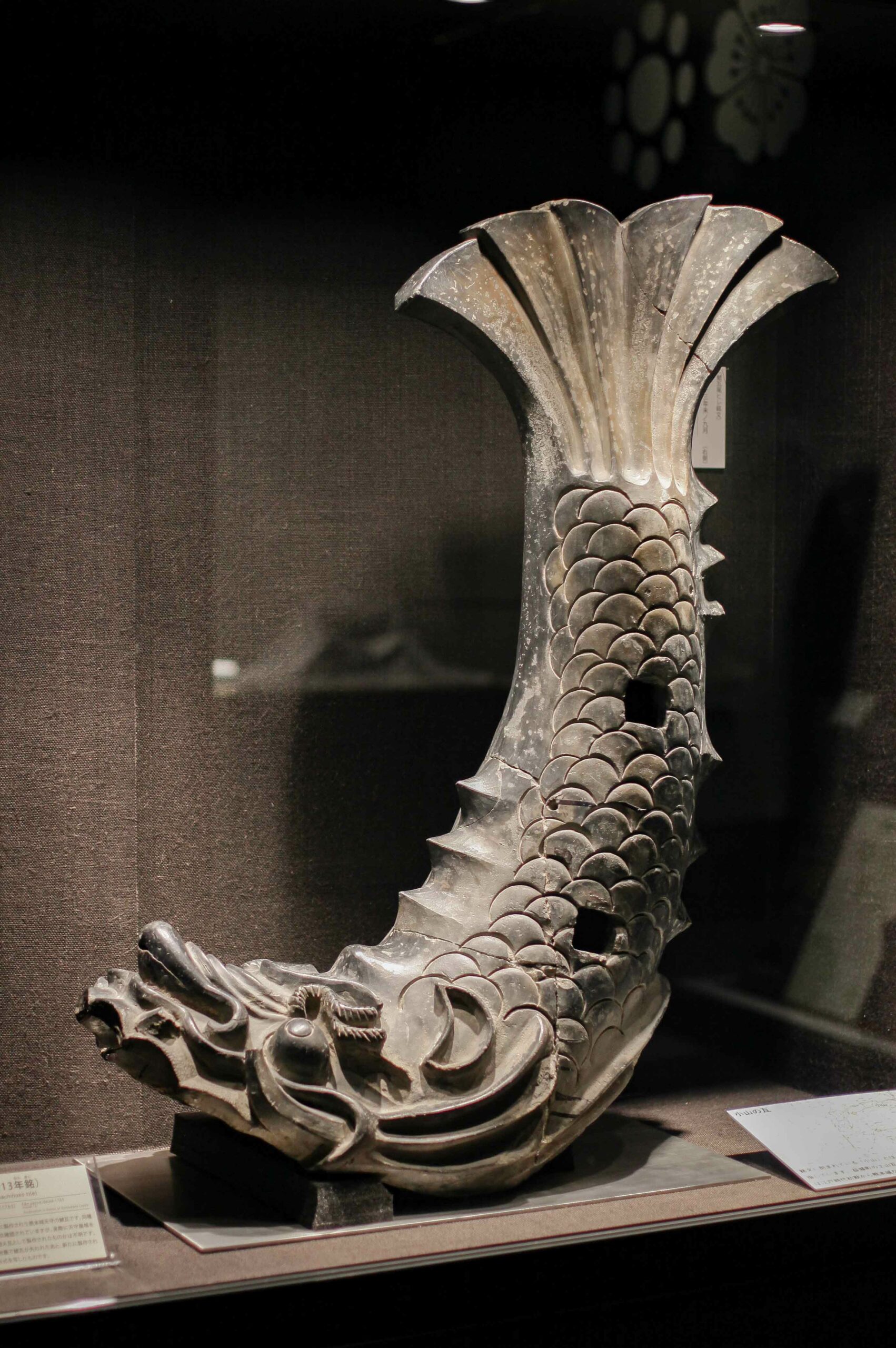
Kumamoto City Museum’s first floor progresses through Kumamoto’s history in a linear manner, moving from Kofun period burial rites, to the emergence of centralised government systems, and the rise of the samurai class. This progression is beautifully illustrated through a selection of artefacts, illuminating the past through universally understandable material culture. Full sets of samurai armour are flanked by shachihoko roof tiles, tying feudal castles seamlessly to their inhabitants.
Ample space is dedicated to the life of Katо̄ Kiyomasa, a feudal lord who also is something of a local hero. Katо̄’s popularity during and after his lifetime arose from his efforts to unify Higo province, now known as Kumamoto prefecture – a place often rife with conflict and power struggles. It was Katо̄ who commissioned the version of Kumamoto castle that people can visit today, and many artefacts relating to his rule are also displayed at the museum within the castle.

Perhaps the most interesting part of the first floor exhibition is the full-scale reconstruction of Japanese domestic spaces from the Meiji, Taishо̄ and early Shо̄wa periods (spanning from 1868 to the mid 1950s). It’s always satisfying to snoop around other peoples’ houses, and doing so while in a museum setting means nobody will walk through the front door and ask you what you’re doing in their home. This section of the museum is a ‘must see’ for anyone interested in antique furniture and folk crafts, as the examples on display are genuine items, offering a realistic view of Japan’s historical home interiors. If you’re desperate for a nose-around beforehand, you can take a look at a digital panorama of one such room on the museum’s website.
Along with depictions of the home, there’s a wide variety of traditional agricultural tools, all beautifully handmade and unique in their character – something else for the folk crafts fans to enjoy. There are further depictions of life outside the home, with rickshaw carriages, rice storage barrels, and even old military uniforms on display. Kumamoto’s history is fraught with conflict, largely owing to its abundant agricultural resources, and access to a sheltered bay; an ideal location for safely stationing a large military fleet. This is reflected in centuries of complex military and political history, all brought to life through the museum’s carefully curated exhibits.

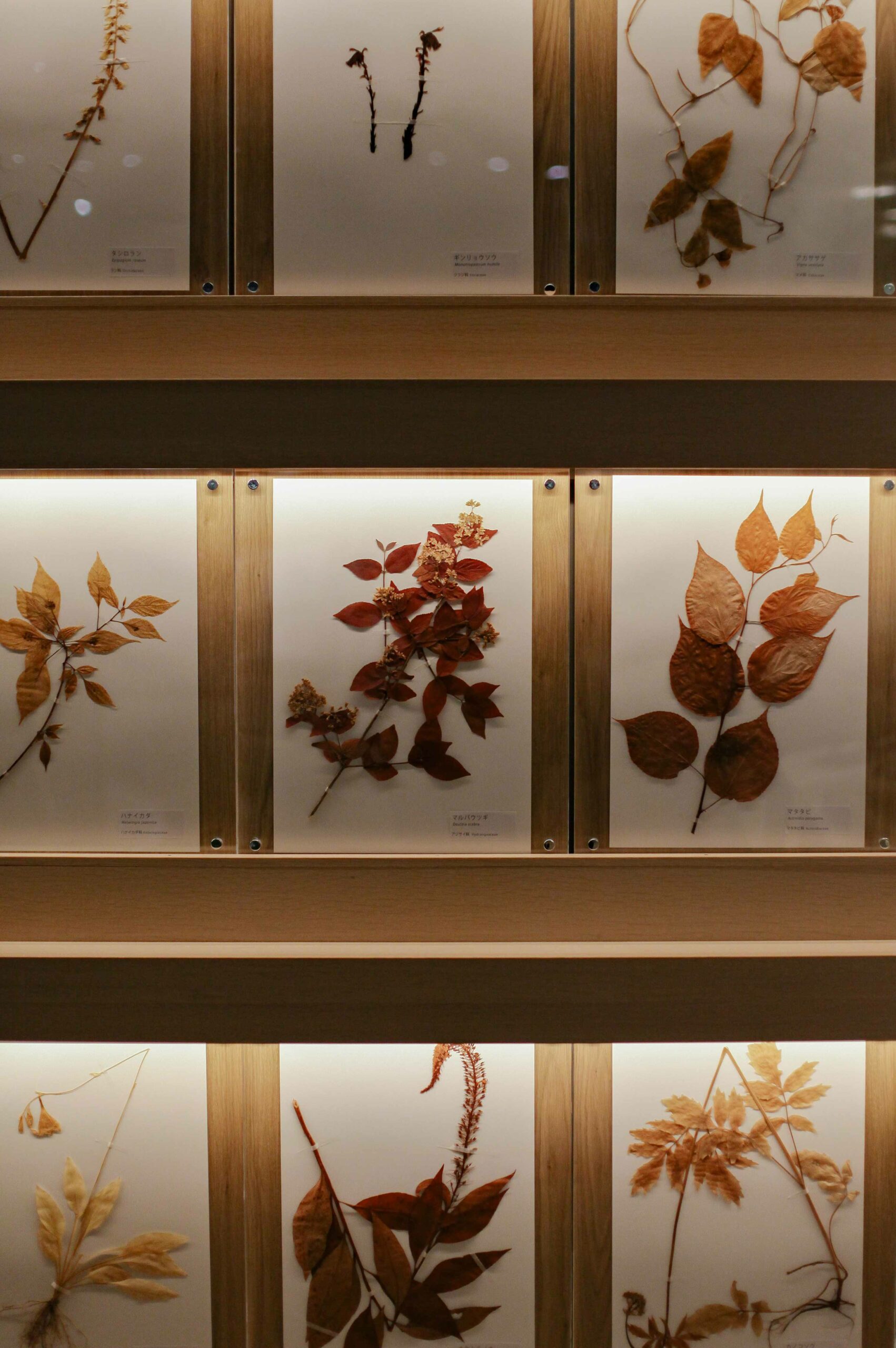
The second floor of the Kumamoto City Museum focuses solely on the natural history of Kumamoto prefecture, with a timeline dating back 500 million years, beginning with the geohistory of the region. Kumamoto, like all of Japan, has been formed and continually shaped by the earth’s active geologies. Japan sits atop the Pacific Ring of Fire, whose boundaries are defined by tectonic subduction zones (where one drifting plate of the earth’s crust is forced below another plate). These subduction zones are permanent sites of volcanoes and earthquakes, both of which have formed Japan’s varied topography over millions of years. Kumamoto is especially susceptible to intense geological activity, with a high number of active volcanoes and frequent earthquakes.
Visitors are invited to get hands-on with the museum’s geological artefacts at the on-site ‘geology laboratory’, and to learn more about the tools and techniques used in geological field studies. A vast display of minerals and fossils covers an entire wall of the inner hall, progressing in chronological order from the region’s earliest samples, to volcanic rocks gathered from recent eruptions.

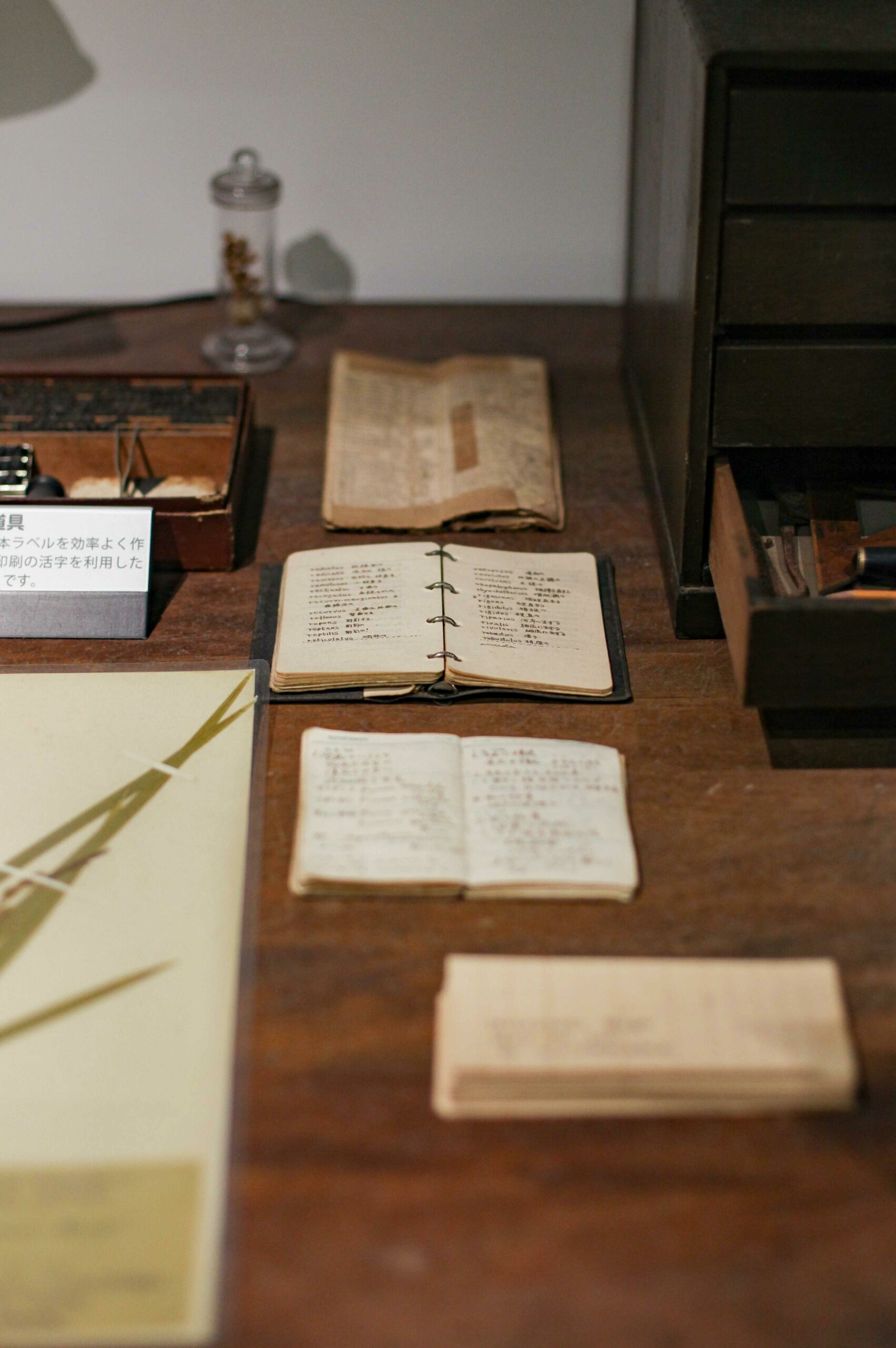
The hall branches off into zones detailing the diversity of two bioregions: Lake Ezu and Mt Kinbo. Lake Ezu’s water rises from the ground as natural volcanic springs, making it remarkably clear, and rich in minerals. It’s also home to a huge range of plant and animal species, and the museum’s installation creates a submerged ‘fish-eye view’ of the lake. Next door, Mt Kinbo’s biodiversity is showcased through an enormous collection of plant species; each is a genuine, carefully pressed sample, collected from the mountain (technically an extinct stratovolcano).
Further along, an entire wall is given over to a collection of Kumamoto’s insects. Winged insects are pinned in mounted collections, and larger specimens are suspended in large blocks of resin. Largest of all (unfortunately) are the arachnids. Many of Japan’s insects appear to be wrathful survivors of the late-Devonian period (hello, gejigeji and mukade), while others can only be described as ‘a form of divine punishment.’ The Horrible Spider falls into the latter category, and is encased in resin for all to see (never to be unseen). It’s a specimen so grotesque, so baffling, that you’ll be thinking about it for weeks after your visit. Heading towards the museum’s collection of shells may aid in cleansing your eyes.
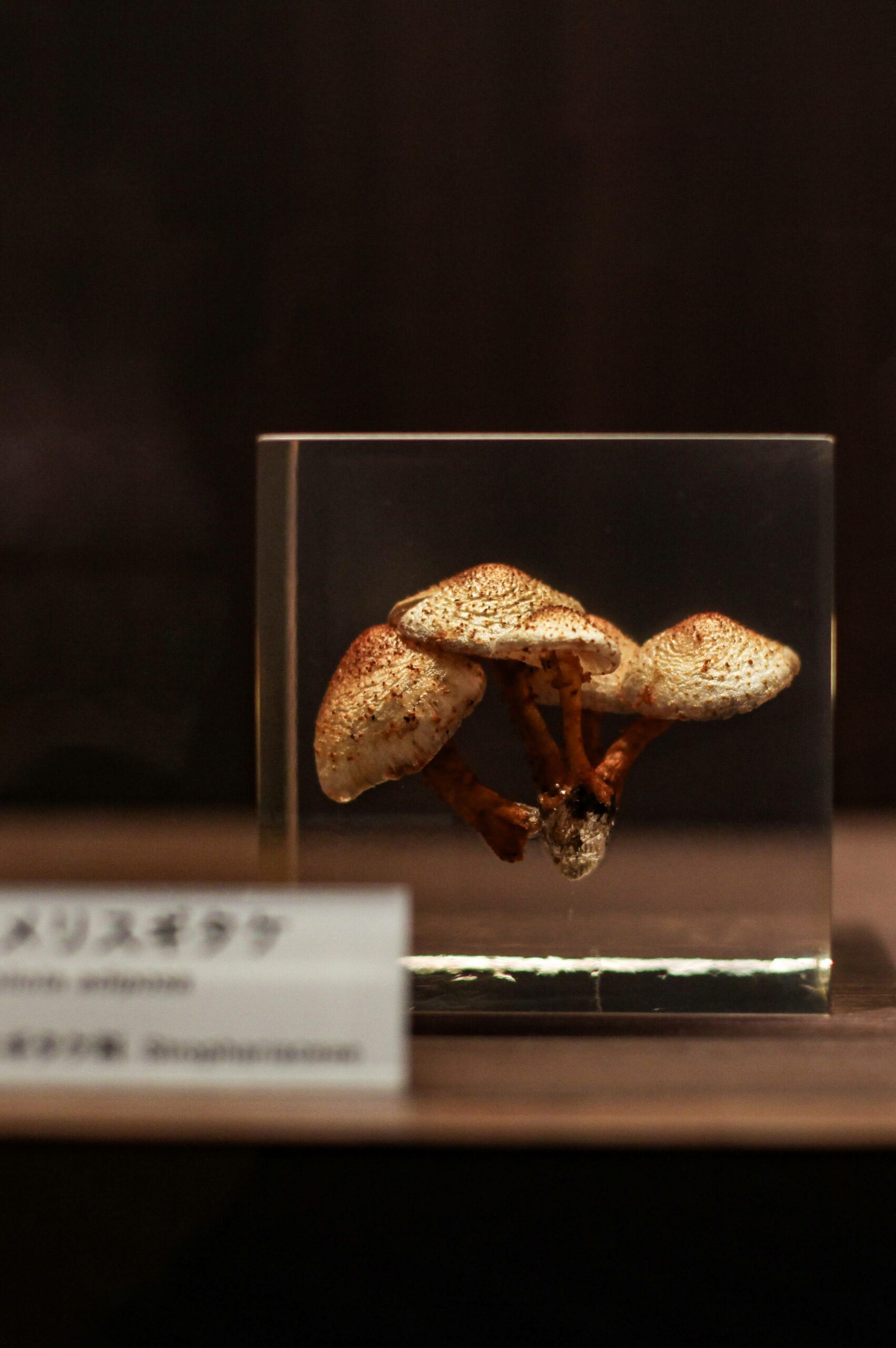
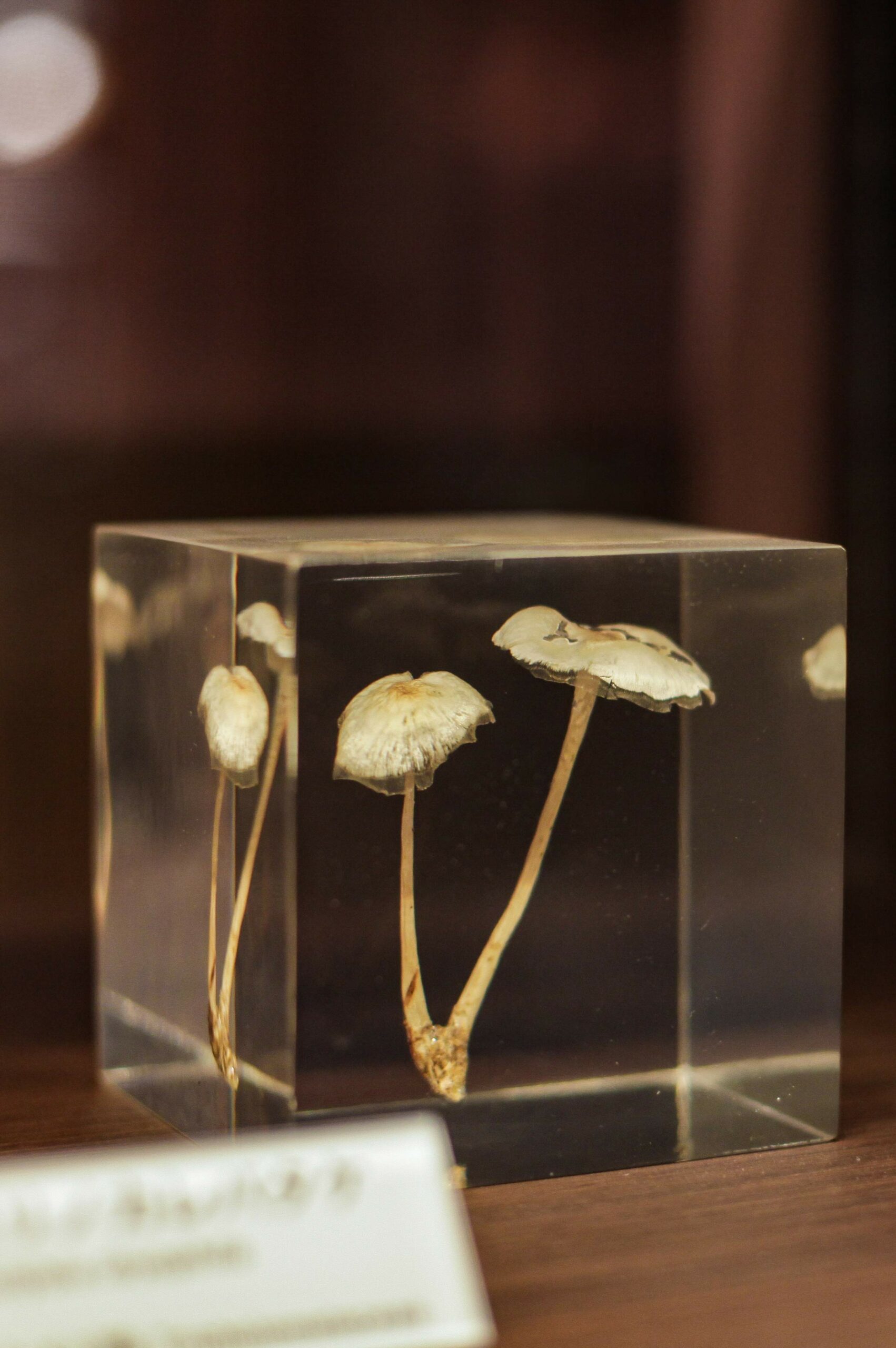
Kumamoto Bay’s mineral-rich volcanic waters have given rise to bivalves and molluscs of the most spectacular variety. Their geometries are fascinating, and their subtly-hued outer shells almost completely hide the opalescent brilliance of their mother-of-pearl interiors. Dividing the shells from the taxidermy display is another ‘botanical wall’, with pressed plant specimens creating a wonderful fusion of botany and interior design. The nature hall’s low light creates a dramatic atmosphere, with spotlit specimens given a sense of drama and intensity. It’s evident that a great amount of design-led planning went into the creation of Kumamoto City Museum, with spectacular results.
Beyond the shell displays, the hall opens out into a high-ceilinged rectangular space, its walls lined with organic specimens. There are further collections of insects, preserved animals, pressed plants – even an entire cabinet reserved for fungi samples suspended in little resin cubes. The end of the route leads you back out towards the geology zone; you’ll pass a replica skeleton of a towering Stegodon (an ancestor of today’s Asian elephant), as well as a diorama of a naturalist’s desk. The desk is neatly arranged with an array of Darwinian tools, and notebooks filled with romantically illegible cursive handwriting, adding a touch of whimsy to Kumamoto City Museum’s visual exposition of science.
The museum’s planetarium is also worth visiting, with scheduled screenings throughout the day. The screenings are in Japanese, but the show is immersive and atmospheric enough to be enjoyed despite any language barrier. Keep watching the skies!
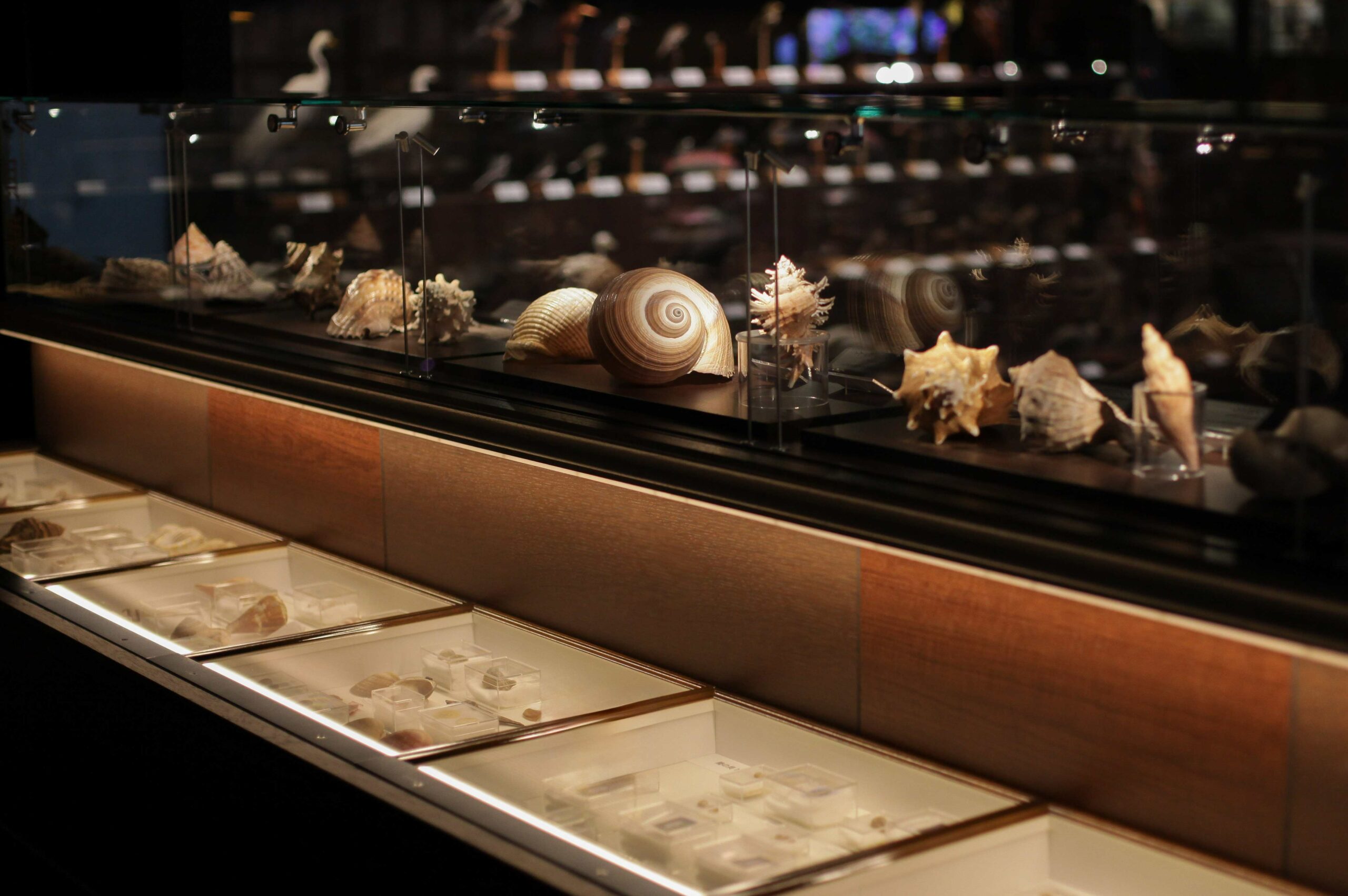
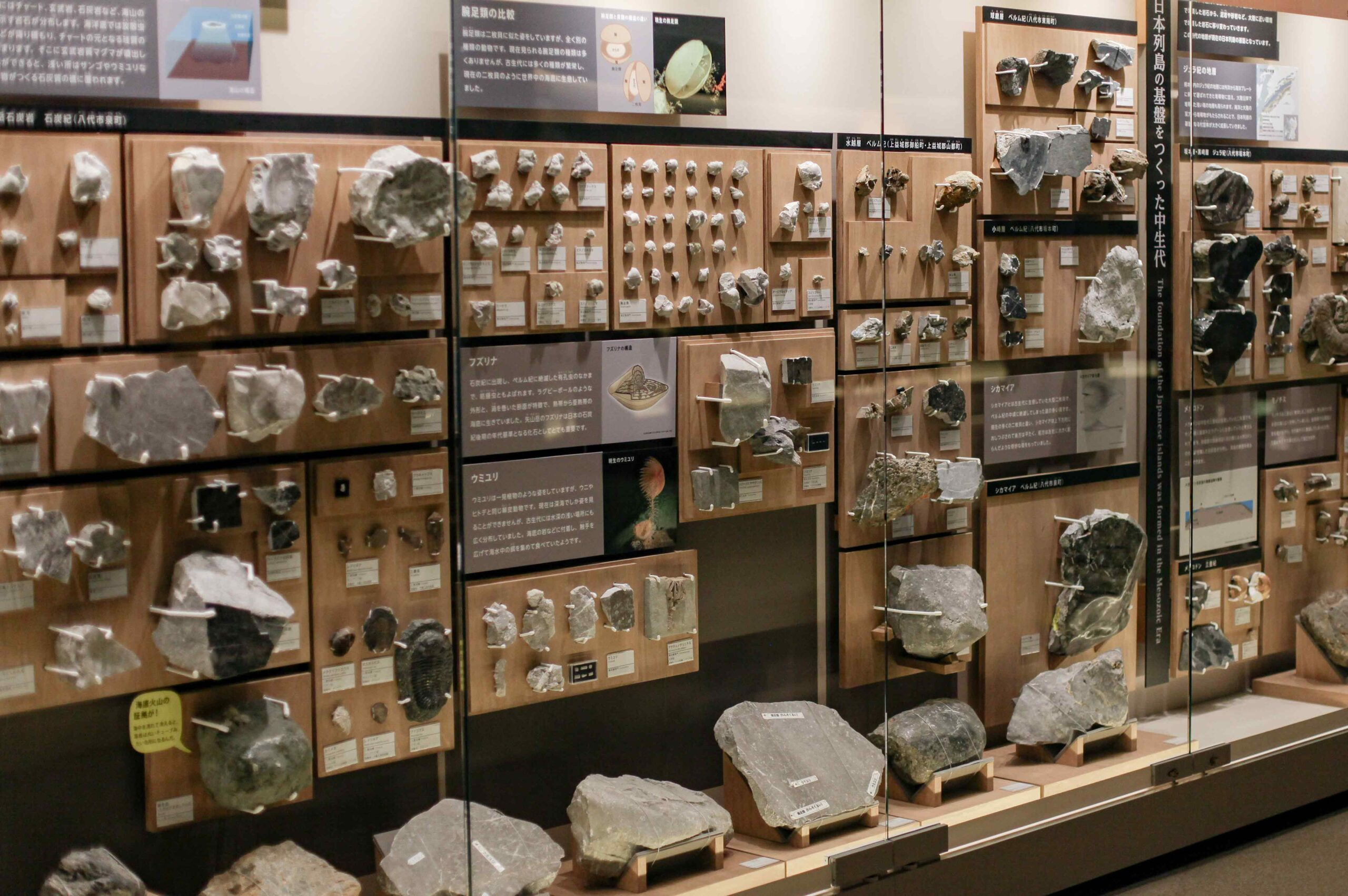
Access: From JR Kumamoto Station, ride the A-line city tram to ‘Sugidomo’ station. The museum is a five-minute walk from here.
Name: Kumamoto City Museum
Address: Kumamoto-shi, Chūō-ku, Furukyōmachi 3-2
Open: 9:00am – 5:00pm (last entry 4:30pm). Closed on Mondays.
Admission: ¥400
Websites:
https://kumamoto-guide.jp/en/spots/detail/13
https://kumamoto-city-museum.jp/282/284
Post by Japan Journeys.











